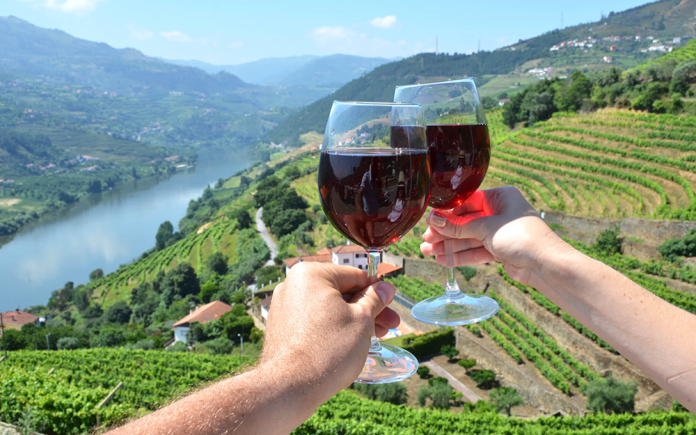
By Rick Riozza
About seven years ago, we wrote an enchanting article in these hallowed pages titled Vintage Ports of Call. It was one of our successful international wine articles to date, with over 17 million views—oops, strike that, rather, over 17 hundred views (hey- in this fast paced world, who’s really counting) coachellavalleyweekly.com/vintage-ports-call
Anyway—the famous sweet dessert wine shipped off from the City of Porto on the north coast of Portugal is traditionally produced from a blend of grapes which most wine enthusiasts can’t pronounce. No need to list them here, as one can Google it in seconds flat.
But our point here is that those same Portuguese grapes used in the production of the sweet Port, are used as well to make a “dry” Port. Most of us already know that traditional Port is a fortified wine: the sweet Port wine doesn’t go through a complete fermentation. Instead, the fermentation is stopped when the ideal sugar level is reached.
The addition of spirits stops the fermentation by creating an environment where the wine yeasts can’t survive. Winemakers add the brandy evenly into the Port wine so that the yeast calmly dies off. Most Port producers use about 30% brandy to reach the legal minimum of 17.5 ABV. An interesting note: most of the brandy used by the Portuguese houses, is imported from South Africa.
Traditional Port has always owned a hearty black fruit profile. But in the last few decades, the brave new world of wine shed some of their sweet teeth and summoned Bacchus and his crew to start producing a “dry” version of Port—along with keeping those delicious unctuous black fruit notes intact.
Now known as “Dry Portuguese Wine”, the country continually produces great tasting, high quality wines at incredibly low prices. And one doesn’t need to go to Trader Joe’s to find a good cheap “dry port”; most wine shops and markets have at least a few labels on the shelves.
For certain, there are just a couple of names one should know when buying dry Port. For perspective, it’s good to keep in mind: what Malbec is to Argentina and Carménère is to Chile, Touriga Nacional is to Portugal.
Another name that’s on many labels of dry Port is Douro Red. The Douro is the river that winds treacherously through the rugged mountain section in the north before flowing out into the Atlantic.
The Douro reds are of course dry with aromas of plum, violets, blackberry, cinnamon, and blueberry. Douro reds are some of the most flavorful/ beefy reds around! Often the wines are intense and bold because they feature a big body, big fruit, high alcohol at 14%. Tannins for the most part are mellow—but for those who love the tannic grip, the wines are out there for you.
Particularly, if you see Touriga Nacional on the label, the wine is lush and opulent; if you see Touriga Franca, the wines are spicier with cinnamon flavors. And by the way—when you see Tinta Roriz Aragonêz, or Alentejo on the label, you may well know this grape already: in Spain, it’s known as Tempranillo—the red wine of Rioja; so here one can expect a little more herb and earth to the fruity mix.
And now: some of our favorite dry ports to recommend.
A new wine in our wine aisle is the 2020 Silk & Spice Red Blend that sells for $14.90/or $9.99 when mix or matching six bottles at Ralphs Markets. It’s a very good wine for the price.
The winemaker notes state: A ruby colored red wine blend, characterized by intense aromas of ripe red and black fruit, such as blackberries and ripe plum. A spicy character evokes vanilla, black pepper and pink peppercorn, combined with hints of mocha. It is full-bodied with a balanced taste, very soft tannins and a long and balanced finish.
Blend: 40% Touriga Nacional, 20% Baga, 20% Alicante Bouchet, 20% Syrah
Another tasty blend is the 2018 Broadbent Douro Reserva $24.99. “Polished red featuring a blend of Tinta Roriz, Tinta Barroca, Touriga Nacional and Touriga Franca, aged for 12 months in oak. Elegant combination of ripe black cherry and blueberry compote with layers of clove and vanilla notes that frame a lovely finish.”
A very velvety red featuring Touriga Nacional old vines (some over 80+ years old) and Sousao grapes is the 2018 Macanita Douro $29. “This wine is aged for 12 months in a blend of new and old French oak and features abundant plum and blueberry preserves aromas combined with scented floral notes.”
 The 2019 Herdade Do Esporao Monte Velho Red is a great buy at $9.99. “An everyday red with substance, made from 40% Aragonêz, 35% Trincadeira, 20% Touriga Nacional, and 5% Syrah. It delivers fresh red cherry and vanilla notes, subtle tannins tune up the finish.”
The 2019 Herdade Do Esporao Monte Velho Red is a great buy at $9.99. “An everyday red with substance, made from 40% Aragonêz, 35% Trincadeira, 20% Touriga Nacional, and 5% Syrah. It delivers fresh red cherry and vanilla notes, subtle tannins tune up the finish.”
The 2018 Altano Douro Red at $12.99 is also a very good buy. “Suave red made from a blend of Touriga Franca, Tinta Roriz and Tinta Barroca. This blend offers plum, glazed cherries and licorice notes that mark the spicy peppery finish.”
And finally, the 2015 Quinta do Ataide Douro Red at $25.99 has got some age for a mellow quaff. “Concentrated red made from a blend of Touriga Nacional, Touriga Franca, Tinta Roriz, Tinta Cao and Tinta Barroca. Aged for 10 months in French oak. It features prune sauce and brambly notes that complement the interesting fleshy finish.”
Saúde!










































